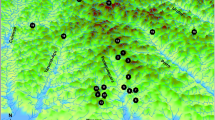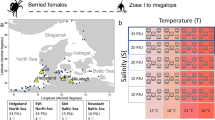Abstract
The objective of the present study was to investigate the population genetic structure of the commercially important camouflage grouper, Epinephelus polyphekadion (Bleeker, 1849), in the western and central Pacific Ocean to improve existing management. Camouflage grouper are widely distributed in the Indo-Pacific and form brief, seasonal, spawning aggregations that are often heavily fished. The present study examined populations sampled in 1997–1998 at five sites in the western central Pacific spanning a geographic distance of ~5,000 km: New Caledonia, Great Barrier Reef, Palau, Marshall Islands, and Pohnpei (Micronesia). Primer pairs were developed to examine genetic variation at three polymorphic microsatellite loci. Cluster analysis, using genetic distance, revealed three regional groupings: (1) Palau, (2) Pohnpei and the Marshall Islands, and (3) the Great Barrier Reef and New Caledonia. Highly significant allele frequency differences were observed among sites. At Pohnpei, significant allele frequency differences in successive years were also apparent, possibly related to genetic variation among cohorts or between local spawning groups. The inter-annual differences at Pohnpei suggest that there may be further genetic structuring over relatively modest distances, a finding relative to determining management units for this commercially valuable species and suggests that future studies need to incorporate possible small-scale temporal or spatial components into study design.




Similar content being viewed by others
References
Aubert H, Lightner DV (2000) Identification of genetic populations of the Pacific blue shrimp Penaeus stylirostris of the Gulf of California, Mexico. Mar Biol 137:875–885
Avise JC, Shapiro DY (1986) Evaluating kinship of newly settled juveniles within social groups of the coral reef fish Anthias squamipinnis. Evolution 40:1051–1059
Brookfield JFY (1996) A simple new method for estimating null allele frequency from heterozygote deficiency. Mol Ecol 1996:453–455
Casselle JE, Warner RR (1996) Variability in recruitment of coral reef fishes: the importance of habitat at two spatial scales. Ecology 77:2488–2504
Chapman RW, Bortone SA, Woodley CM (1996) A molecular approach to stock identification and recruitment patterns in red snapper (Lutjanus campechanus). In: Arreguin-Sanchez F, Munro JL, Balgos MC, Pauly D (eds) Biology, fisheries and culture of tropical groupers and snappers. ICLARM Conf Proc 48:85–91
Chapman RW, Sedberry GR, Koenig CC, Eleby BE (1999) Stock identification of gag, Mycteroperca microlepis, along the southeast coast of the United States. Mar Biotechnol 1:137–146
Domeier ML, Colin PL (1997) Tropical reef fish spawning aggregations: defined and reviewed. Bull Mar Sci 60:698–726
Dudgeon CL, Gust N, Blair D (2000) No apparent genetic basis to demographic differences in scarid fishes across continental shelf of the Great Barrier Reef. Mar Biol 137:1059–1066
Fisher RA (1954) Statistical methods for research workers, 12th edn. Oliver and Boyd, Edinburgh
García-Machado E, Robainas A, Espinosa G, Oliva M, Páez J, Verdecia N, Monnerot M (2001) Allozyme and mitochondrial DNA variation in Cuban populations of the shrimp Farfantepenaeus notialis (Crustacea: Decapoda). Mar Biol 138:701–707
Guo SW, Thompson EA (1992) Performing the exact test of Hardy Weinberg proportion for multiple alleles. Biometrics 48:361–372
Haldane JBS (1954) An exact test for randomness of mating. J Genet 52:631–635
Heemstra PL, Randall JE (1993) FAO species catalogue, vol 19: groupers of the world family Serranidae, subfamily Epinephelinae. An annotated and illustrated catalogue of the grouper, rockcod, hind, coral grouper and lyretail species known to date. FAO Fish Synop 16:1–382
Heggarty KA, Weissel JK (1988) Complexities in the development of the Caroline Plate region, western equatorial Pacific. In: Narin AEM, Stehli FG, Uyeda S (eds) The ocean basins and margins, vol 7B: the Pacific Ocean. Plenum, New York, pp 277–301
Heist EJ, Gold JR (2000) DNA microsatellite loci and genetic structure of red snapper in the Gulf of Mexico. Trans Am Fish Soc 129:469–475
Jones GP, Milicich MJ, Emslie MJ, Lunow C (1999) Self-recruitment in a coral reef fish population. Nature 402:802–804
Lacson JM, Morizot DC (1991) Temporal genetic differences in subpopulations of bicolor damselfish (Stegastes partitus) inhabiting coral reefs in the Florida Keys. Mar Biol 110:353–357
Leis JM, Carson-Ewart BM (1998) Complex behaviour by coral-reef larvae in open-water and near-reef pelagic environments. Environ Biol Fishes 53:259–266
Leis JM, Carson-Ewart BM (2000) Behaviour of pelagic larvae of four coral-reef species in the ocean and an atoll lagoon. Coral Reefs 19:247–257
Lewis RI, Thorpe JP (1994) Temporal stability of gene frequencies within genetically heterogeneous populations of the queen scallop Aequipecten (Chlamys) opercularis. Mar Biol 121:117–126
Manly BFJ (1991) Randomization and Monte Carlo methods in biology. Chapman and Hall, New York
Miller MP (1997) Tools for population genetic analysis (TFPGA), version 1.3. A Windows program for the analysis of allozyme and molecular population genetics data. http://bioweb.usu.edu/mpmbio/tfpga.htm
Nei M (1978) Estimation of average heterozygosity and genetic distance from a small number of individuals. Genetics 89:583–590
O'Connell M, Wright JM (1997) Microsatellite DNA in fishes. Rev Fish Biol Fish 7:331–363
Palumbi SR (1997) Molecular biogeography of the Pacific. Coral Reefs 16:47–52
Planes S, Parroni M, Chauvet C (1998) Evidence of limited gene flow in three species of coral reef fishes in the lagoon of New Caledonia. Mar Biol 130:361–368
Raymond M, Rousset F (1995) A population genetics software for exact test and ecumenicism. J Hered 86:248–249
Rhodes KL, Sadovy Y (2002a) Reproduction in the camouflage grouper, Epinephelus polyphekadion (Pisces: Serranidae), in Pohnpei, Federated States of Micronesia. Bull Mar Sci 70:851–869
Rhodes KL, Sadovy Y (2002b) Temporal and spatial trends in spawning aggregations of camouflage grouper, Epinephelus polyphekadion (Bleeker, 1849), in Pohnpei, Micronesia. Environ Biol Fishes 63:27–39
Roberts CM (1996) Settlement and beyond: population regulation and community structure in reef fishes. In: Polunin NVC, Roberts CM (eds) Reef fisheries. Chapman and Hall, London, pp 85–112
Rosenblatt RH, Waples RS (1986) A genetic comparison of allopatric populations of shore fish species from the eastern and central Pacific Ocean: dispersal or vicariance? Copeia 1986:275–284
Rozen S, Skaletsky HJ (1998) Primer 3. http://www.genome.wi.mit.edu/genome/cgo-bin/primer/primer3_www.cgi
Ruzzante DE (1998) A comparison of several measures of genetic distance and population structure with microsatellite data: bias and sampling variance. Can J Fish Aquat Sci 55:1–14
Sadovy Y (1994) Grouper stocks of the western central Atlantic: the need for management and management needs. Proc Gulf Caribb Fish Inst 43:43–64
Sadovy Y, Vincent A (2002) Ecological issues and the trade in live reef fishes. In: Sale P (ed) Coral reef fishes: dynamics and diversity in a complex ecosystem. Academic, London
Sedberry GR, Stevenson DE, Chapman RW (1998) Stock identification in Nassau grouper, Epinephelus striatus, using microsatellite DNA analysis. Proc Gulf Caribb Fish Inst 50:727–749
Sokal RR, Rohlf FJ (1995) Biometrics, 3nd edn. Freeman, San Francisco
SPSS (1999) SPSS for Windows, release 10.0.0. SPSS, Chicago
Stevens GR (1977) Mesozoic biogeography of the south-west Pacific and its relationship to plate tectonics. In: Proceedings of the international symposium on geodynamics in south-west Pacific Noumea (New Caledonia). Editions Technip, Paris, pp 309–326
Swearer SE, Caselle JE, Lea DW, Warner RR (1999) Larval retention and recruitment in an island population of a coral-reef fish. Nature 402:799–802
Weir BS, Cockerham CC (1984) Estimating F-statistics for the analysis of population structure. Evolution 41:1358–1370
Workman PL, Niswander JD (1970) Population studies on southwestern Indian tribes. II. Local genetic differences in Papago. Am J Hum Genet 22:24–29
Acknowledgements
The authors thank A. Ball, L. Chapman, B. Eleby, M. Kulbicki, E. Liew, N. Morgan, A. Olpet, B. Paul, M. Samoilys and L. Squire. Institutional support was provided by IFREMER, the Marine Environmental Research Institute of Pohnpei (MERIP), the Overseas Fisheries Cooperation Foundation (OFCF), Pohnpei Office of Marine Development, Marshall Islands Marine Resource Authority (MIMRA), and Coral Reef Research Foundation (CRRF). The authors would also like to thank the people of Pohnpei, Kitti Municipality, and the Pohnpei State Government. Research funding was provided by the Research Grants Council of the Hong Kong SAR (HKU7246/97 M) and the American Museum of Natural History, Lerner–Grey Foundation. These experiments comply with the current laws of the Hong Kong Special Administrative Region, People's Republic of China.
Author information
Authors and Affiliations
Corresponding author
Additional information
Communicated by J.P. Grassle, New Brunswick
Rights and permissions
About this article
Cite this article
Rhodes, K.L., Lewis, R.I., Chapman, R.W. et al. Genetic structure of camouflage grouper, Epinephelus polyphekadion (Pisces: Serranidae), in the western central Pacific. Marine Biology 142, 771–776 (2003). https://doi.org/10.1007/s00227-002-1002-7
Received:
Accepted:
Published:
Issue Date:
DOI: https://doi.org/10.1007/s00227-002-1002-7




